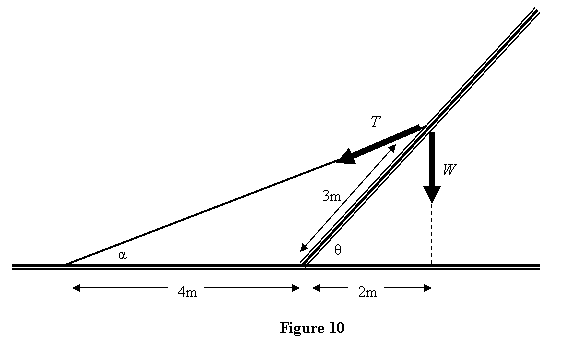Example 1: A pendulum in equilibrium as
shown in figure 5. We show the coordinates of the
bob in the figure 7 below.



If the pendulum is give a virtual displacement i.e. 

By the principle of virtual work, the total virtual work
done by the external forces vanishes at equilibrium.
So the equilibrium is described by

giving

Which is the same answer as obtained earlier.
Example 2: This is the problem involving
two crossed bars as shown in figure 2. We wish to calculate
the force F required to keep the system in
equilibrium using the principle of virtual work.
To apply the principle of virtual work, imagine a virtual
displacement consistent with the constraint. The only
displacement possible - because of only one degree of
freedom - is that  .
From figure 2 it is clear that the external forces on
the system are F and 2mg (weight
of the bars).
.
From figure 2 it is clear that the external forces on
the system are F and 2mg (weight
of the bars).

As θ increased to θ + Δθ , the point where the bars cross
moves down by a distance (see figure 8)

and the point when F is applied moves to the
right by a distance

To calculate the net virtual work done, I remind you that
work by a force  is
calculated by taking the dot product
is
calculated by taking the dot product  ,
where
,
where  represents
the displacement of the point where the force is being
applied. Thus the virtual work in the present case is
represents
the displacement of the point where the force is being
applied. Thus the virtual work in the present case is

For equilibrium we equate this to zero to get

which is the same result as obtained earlier.
So you see in both these examples that by applying the
method of virtual work, we have bypassed calculating
the constraint forces completely and that is what makes
the method easy to implement in large systems. The way
to learn the method well is to practice as many problems
as possible. I will now solve some examples to demonstrate
the usefulness of the method for large system. To start
with let us take the example which we gave in the beginning
- that of toy with made with bars.
Example 3: If there are N crossings
in the folding toy shown in figure 9, what is the force
required to keep the system in equilibrium?

Again the degree of freedom = 1. The variable we use to
describe the position of the mechanism is the angle between
the bars i.e. θ. As the angle θ is changed to (θ+ Δθ),
the upper end of the bar where force F is applied
moves in the direction opposite to the force by

Thus the virtual work done by F is

On the other hand, the first crossing moves down by

The second crossing by

and the Nth crossing moves down by
 All
these displacements are in the same direction as the
force = 2mg at each of the bar crossings. Thus
the virtual work done by the weight of the mechanism
is
All
these displacements are in the same direction as the
force = 2mg at each of the bar crossings. Thus
the virtual work done by the weight of the mechanism
is

This gives a total virtual work done by the external forces
to be

Equating this to zero for equilibrium gives

For N = 1 the answer matches with that obtained
in the case of only two bars in example 2 above. For
larger N , the force required to keep equilibrium
goes up by a factor of N2 .
Example 4: A 6m long electric
pole of weight W starts falling to one side during rains.
It is kept from falling by tying a strong rope at its
centre of gravity (assumed to be right in the middle
of the pole) and securing the other end of the rope on
ground. All the relevant distances are given in figure
10. Assume that the lower end of the pole is like a pin
joint. Under these conditions we want to find the tension
in the rope using the method of virtual work.

In this problem also there is only one degree of freedom θ.
The constraint is that the pole can only rotate about
the assumed pin joint at the ground. The constraint forces
are the reactions at the ground and do no work on the
pole when it rotates. There is also the constraint of
the rigidity of the pole. Extend forces are W and T.
By principle of virtual work when θ is
changed to ( θ + Δ θ ) ,
the total virtual work vanishes. If the centre of gravity
moves up by Δy and to the left by Δx as θ is
increased to ( θ + Δθ
) , the virtual work done is

which, when equated to zero, gives

From the figure it is easy to see that

and (only the magnitude)

Substituting these in the expression for the tension gives

This concludes the lecture on the method of virtual work.
In the lecture, I have given you an introduction to the
method assuming that constraints do no work. The method
is really useful when there are many constraints and
the system is complicated. It makes calculations easier
by avoiding calculating constraint forces. The method
also provides basis for simplifying dynamics calculations
under constrained motion. You will be learning more about
it in an advanced course.